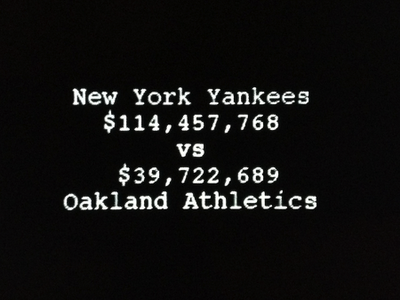
By now, I’m sure most baseball fans have seen the movie Moneyball, which is a sports drama based on the Oakland Athletics’ 2002 season and their general manager Billy Beane, played by Brad Pitt. To be honest with you, the movie had never really piqued my interest until a colleague of mine mentioned that what Beane was trying to do with the ailing baseball team is a lot like what I do when I walk into a business as a coach or a consultant.
Basically, Moneyball is a nonfiction account of what a smart GM can do with limited funds and an in-depth knowledge of baseball statistics. Beane (Brad Pitt) tries to put together a winning team despite a lackluster financial situation and losing key players to free agency. Because of the limited payroll the 2002 Oakland A’s could not afford to pay star players to join their team, so what could they do instead?
Instead of focusing on the flashy players that put people in the seats at games, Beane decided to adopt sabermetrics, which is a specialized analysis of specific aspects of objective evidence, including player statistics. Not only does it analyze what the player has done in the past and present, it can be used to predict the usefulness of a player for any given team in the future.
Beane questioned traditional ideas of skill and put together a team of players based on sabermetrics, not traditional scouting methods (much to the chagrin of his colleagues).
After signing the players who he had deemed an ideal fit for their organization, Beane spent time working with the current roster to determine a game plan that would be most effective based on the skills and strengths of the new roster. Beane worked with the athletes and coaching staff to shape a new team without breaking the bank to sign stars.
As Business Owners of Staffing Agencies and Recruiting Firms we need our own Sabermetrics.
With our RBSmetrics the first thing you do is sit down and assess the individuals who are already present in the organization. Assess who is overvalued, and who is undervalued. Be objective and if there are people who need to be cut from the team, cut them. Then find undervalued recruiters to come in and take their place.
Instead of going out and finding another recruiter who is a “star”, find a diamond in the rough who will support your organization in a way that will drive sales and ultimately push you to that final goal, a win.
After developing the recruitment roster, spend time training and building up your employees in a way that promotes success. Implement a game plan that will help your recruiters use their talents and skills in a way that is most effective for their business and for the organization in general. Also, teach the management that is already present how to keep this game plan on track and to not lose sight of the finish line.
With the RBSMetrics you can create star teams out of players that were previously undervalued by creating strong game plan that caters to their strengths, making them more effective. The RBSMetrics formulas in place that looks just as strange as the Sabermetrics did to the Oakland A’s.
If you still doubt that a team of ragtag, undervalued professionals can come together to win, don’t forget that after their second year with the Sabermetric model the Boston Red Sox won the 2004 World Series, which was their first World Series win since 1918.

You need to be a member of RecruitingBlogs to add comments!
Join RecruitingBlogs